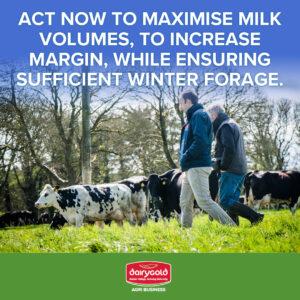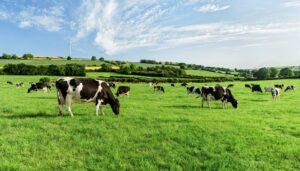Get a 24 hour weather forecast

As we enter the month of August there are a number of key areas that need to be reviewed on dairy farms and decisions that are taken now will help ensure the optimum outcome for the rest of the year. 2024 has presented a number of challenges that need to be addressed and it is crucial that farmers plan now to maximise milk volumes, to increase margin, while also ensuring sufficient winter forage. Dairygold’ s Technical Manager Liam Stack recommends the following series of actions:

Liam Stack: Ruminant Technical Manager
1. Evaluate Your Winter Fodder Situation:
The first step is to assess your current winter fodder position, by completing a fodder budget, so that you can know exactly where you stand. The most recent Teagasc fodder survey completed in June found that dairy farmers had 60% of their winter fodder requirements conserved, in a standard year this figure would be 70% or more. More recently second cut silage yields have been less than anticipated in many cases. Completing a review now will allow you to take any actions necessary.
2. Maximise Milk Volumes, increasing margin to Year End:
It is important to remember that each cow in your herd still has the potential to produce in excess of €1,000 of milk from now until drying off. So far this year, cows have produced approximately 3,400 Litres, with a year-end target of 5,800 Litres. With 2,400 Litres of high solids, high value milk left to produce this is an opportunity to deliver significant margin which should be maximised.
3. Grow the Grass Needed for Your Grass Wedge:
You will need to prioritise N for the grass wedge first, and then you can allocate any remaining N towards a third cut of silage. Ensuring a sufficient grass wedge to the end of grazing season is crucial for maximising milk production.

4. Remove Any Stock You Can from the Farm:
To lower grass demand and make it easier to build the grass wedge, consider removing any stock you can from the dairy platform. This includes weanlings, in-calf heifers, and unproductive cows. By reducing grass demand, you will not only help in building the grass wedge, but you will also be increasing your potential to make a third cut of silage, at the same time.
5. Source Additional Fodder:
You could also look into sourcing fodder off-farm, such as grass or maize silage, whole crop, or straw. Additionally, you could consider alternative feeds like beet, and potatoes, for your herd. These feeds can be viable alternatives to replace grass silage, especially if you have a high stocking rate. The higher your stocking rate the more outsourcing of forage will be required.
6. Adjust Feeding Strategies:
In a typical year for any farm stocked at 4 livestock units (LU) per hectare, the recommendation would be silage plus 3 kgs of concentrates to build the grass wedge. If silage is unavailable, you should increase this to 5-6 kgs of concentrates. This feeding is imperative and should be a priority as the grass wedge will drive milk production to the year end.
To grow a third cut of silage alongside building the grass wedge, additional feeding on top of these rates will be a necessity. The amount required will be dependent on your stocking rate and the amount of forage you need to preserve. Feeding 5 kgs of a forage extender for August and September can help conserve approximately 18-20% of your dairy cows’ winter needs as silage. Lower stocking rates require less extra feeding, making it more manageable.
Every farm situation will be unique and requires its own farm-specific plan. You need to determine:
Depending on your answers to each of these questions, you may not need that much feed to meet your requirements, therefore do a fodder budget to see what your options are.
Your Area Sales Manager is on hand to help you develop a farm specific plan that works for you, so get in touch with them as soon as possible.
Do not worry, if all fails, secure enough straw. The recent change to the straw incorporation scheme and the straw baling incentive should ensure there will be straw available this year. If you have straw, you can get through the winter on limited silage feeding.
Please talk to your Area Sales Manager today and they will work with you on your winter nutrition programmes based on your farm situation.